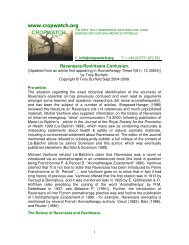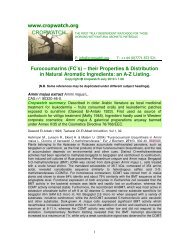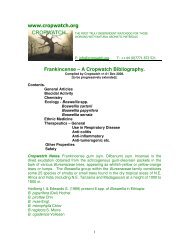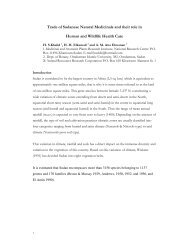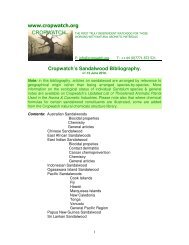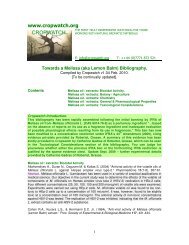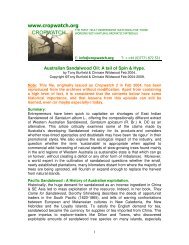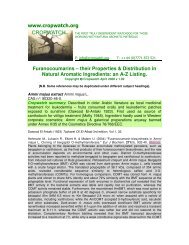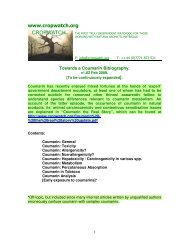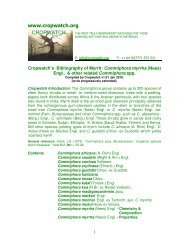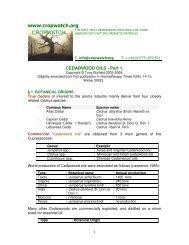The Adulteration Of Essential Oils - Cropwatch
The Adulteration Of Essential Oils - Cropwatch
The Adulteration Of Essential Oils - Cropwatch
Create successful ePaper yourself
Turn your PDF publications into a flip-book with our unique Google optimized e-Paper software.
Impurities in synthetic linalol made via the older acetylene or β-pinene routes<br />
(e.g. dehydrolinalol, dihydrolinalol, tetrahydrolinalol, plinol & others), don’t<br />
occur naturally in linalol-containing essential oils such as lavender (Lavandula<br />
angustifolia). <strong>The</strong>refore the presence of dehydrolinalol etc, used to be<br />
relatively easy way of identifying synthetic linalol in a lavender oil GC<br />
chromatogram. Nowadays, cleaner linalol can be manufactured via the αpinene<br />
process and its’ presence in oils is less easily detectable. Cheaper<br />
grades containing impurities are still employed however, so that in cheap<br />
linalyl acetate (which is derived from linalol), it is still often possible to detect<br />
traces of, dihydrolinalyl-, pinanyl- or plinyl acetates, thus giving away its’<br />
origin.<br />
Enantiomeric analysis.<br />
<strong>Essential</strong> oils invariably contain substances with one or more asymmetric<br />
carbon atoms, which give rise to different optical isomers (enantiomers). <strong>The</strong><br />
distribution ratios of these different enantiomers (as determined by GC using<br />
chiral columns) can be used as a powerful tool to detect oil adulteration by<br />
nature-identical synthetics. A review of enantioselective GC analysis is<br />
provided by Mosandl (1998); uses of enantiomeric analysis in establishing<br />
lavender oil authenticity is reported by Kreis and Mosandl (1992) and for<br />
bergamot oil by Cotroneo et al. (1992). A few of examples of specific oil<br />
constituents showing high levels of optical purity include:<br />
<strong>Essential</strong> Oil Enantiomeric Ratio Enantiomeric<br />
Excess<br />
Reference<br />
Bergamot oil: (4R)-(-)-linalol to 100%; 100 Cotroneo et al.<br />
(Citrus bergamia) (4S)-(+)-linalol 0%.<br />
(1992)<br />
Fennel oil<br />
(4R)-(+)-α-phellandrene 100%; 100 Cassiabanca<br />
(4S)-(-)-α-phellandrene 0%<br />
(1996)<br />
(Foeniculum vulgaris)<br />
Ho leaf oil<br />
(4R)-(-)-linalol 96.2%;<br />
92.4 Bernreuther &<br />
(Cinnamomum spp) (4S)-(+)-linalol 3.8%<br />
Schreier (1991)<br />
Lavender oil (4R)-(-)-linalyl acetate >99%; 98 +<br />
(Lavandula<br />
angustifolia)<br />
(4S)-(+)-linalyl acetate





